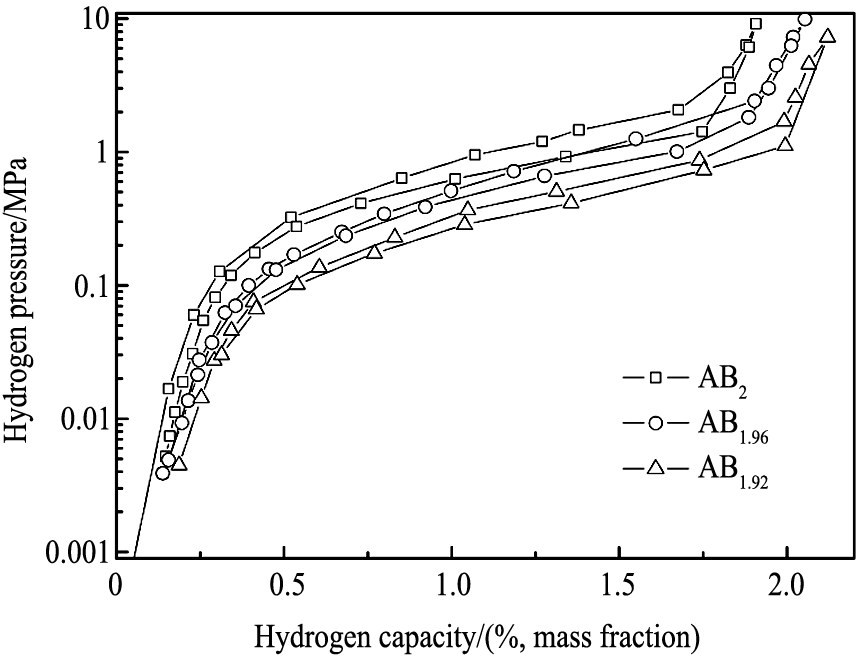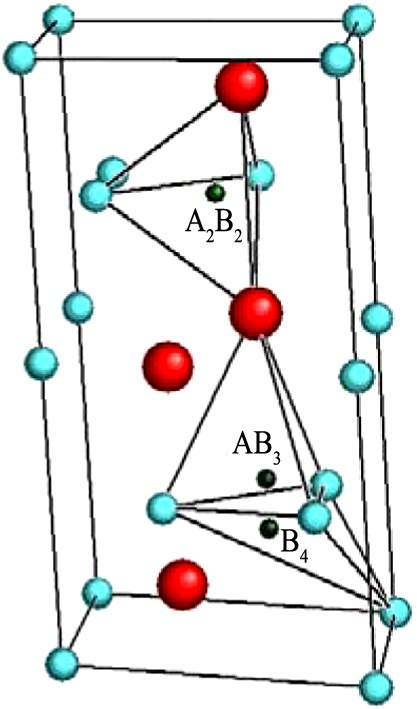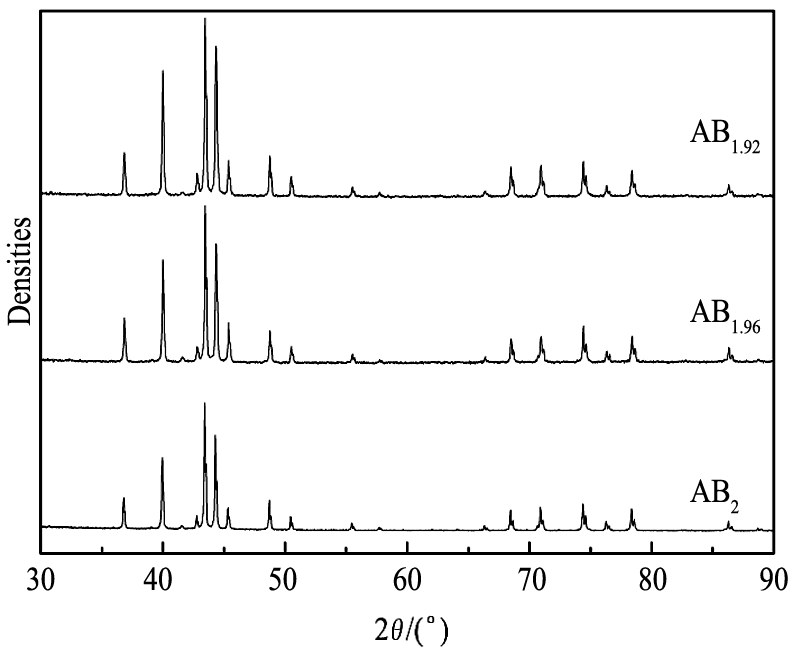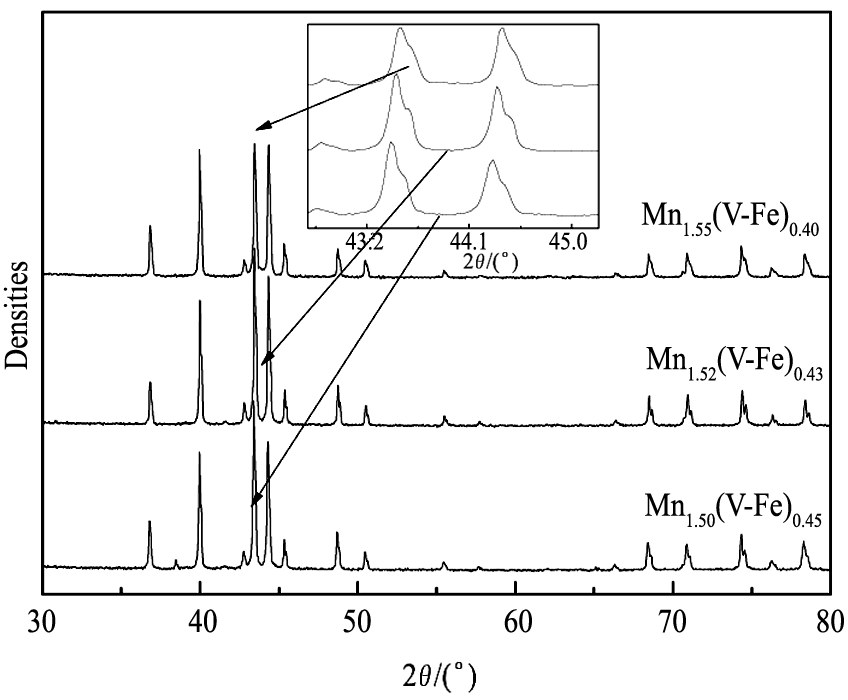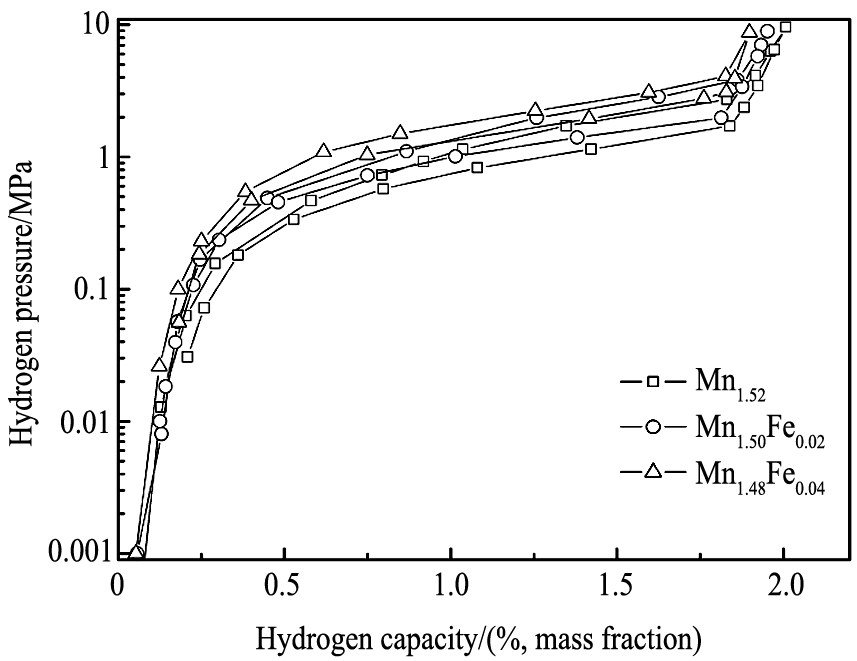网络首发时间: 2018-09-21 08:55
Ti-Mn系AB2型Laves相储氢合金研究
全球能源互联网研究院有限公司先进输电技术国家重点实验室
有研科技集团有限公司有研工程技术研究院有限公司能源材料与技术研究所
摘 要:
以AB2型Laves相储氢材料Ti-Zr-Mn-Cr-V-Fe为基础,系统研究了A侧和B侧元素比例调整对合金储氢容量、平台特性等的影响。结果表明,随着A/B的增大,合金吸氢容量明显增大,吸放氢平台压力降低,滞后减小,平台斜率有所增大。这种现象可通过“局域环境模型”来解释,而合金吸氢容量随A/B比值的增大而增大的现象还与合金DEC(d-electron concentration)值的降低有关。随着B侧Mn/V-Fe比值的增大,合金平台压力升高,平台斜率和滞后均有所降低,吸氢容量也略有降低,这是合金中具有较大d电子数的Mn元素增多造成高Mn/V-Fe比合金的DEC值较大导致的。Fe/Mn值增大,则会导致平台压力明显升高,合金吸氢容量降低,平台斜率明显减小,吸放氢滞后也略有降低。最终优化出综合储氢性能良好的TiZr0.02Mn1.50Cr0.05(V-Fe)0.43Fe0.02合金,该合金25℃吸氢,合金的有效储氢容量为1.73%(质量分数)。
关键词:
中图分类号: TG139.7
作者简介:刘海镇(1988-),男,福建泉州人,博士,工程师,研究方向:储氢材料及固态储氢技术,E-mail:lhzju@qq.com;*郭秀梅,高级工程师;电话:18612291978;E-mail:xiumei418@163.com;
收稿日期:2018-04-27
基金:国家电网公司科技项目(SGRIDGKJ[2016]123);北京市科技计划项目(Z171100000917012)资助;
Hydrogen Storage Properties of Ti-Mn Based AB2-Type Laves Phase Alloys
Liu Haizhen Xu Li Guo Xiumei Wu Yuanfang Li Zhinian Wang Shumao
State Key Laboratory of Advanced Transmission Technology,Global Energy Interconnection Research Institute Co.,Ltd.
Institute of Energy Materials and Technology,GRIMAT Engineering Institute Co.,Ltd.,GRINM Group Co.,Ltd
Abstract:
Based on AB2-type Laves phase hydrogen storage alloy Ti-Zr-Mn-Cr-V-Fe, the influences on hydrogen storage capacities and equilibrium performance by element adjustments in A and B sites were investigated systematically. The results showed that with the increase of A/B ratio, the hydrogen capacity increased monotonously; the hydrogen absorption/desorption plateau and hysteresis decreased distinctly; the slope factor showed increasing tendency. These phenomena could be explained by “local-environment model”. The increase of hydrogen capacity was also related to the decrease of DEC(d-electron concentration) with A/B ratio increasing. The increase of Mn/V-Fe in B site of the alloy could lead to the increase of the plateau and the decrease of slope factor, hysteresis and hydrogen capacity. These results resulted from the DEC increase with the Mn/V-Fe ratio increase because of the Mn element with larger d-electron concentration increasing in the alloy. The Fe/Mn ratio increase led to the increase of plateau and the decrease of hydrogen capacity, slope factor and hysteresis. As a result, the alloy TiZr0.02Mn1.50Cr0.05(V-Fe)0.43Fe0.02 was optimized in the studied alloys which showed a high effective hydrogen capacity of 1.73%(mass fraction) at 25 ℃.
Keyword:
Laves phase; Ti-Mn based hydrogen storage alloys; hydrogen capacity; equilibrium pressure;
Received: 2018-04-27
随着化石能源的日益减少, 氢能作为清洁、 无污染的二次能源, 其绿色环保和可循环使用的优越性越来越被人们所关注并加以利用, 成为21世纪极具发展前景的新能源之一。 氢能系统主要包括氢的制取、 储存、 输运和能源转换应用四个主要环节, 其中, 制氢技术是源头, 储氢技术是关键, 燃料电池是核心。 然而在整个氢的大规模应用过程中, 氢的安全、 高效储存是制约氢能应用的主要瓶颈。 以燃料电池汽车为例, 其市场化进程的主要障碍就是储氢系统的低储氢密度。 对于车载储氢系统而言, 高储氢容量、 高吸放氢速率和温和的放氢条件是三个必要因素, 因此, 需要开发出具有高重量储氢密度和体积储氢密度、 吸放氢速率快且低温下即可放氢的储氢系统。 近年来, 固态储氢系统因其较高的体积储氢密度和安全充放氢的特点越来越受到人们的重视, 成为储氢技术发展的一个重要方向。 开发的不同系列储氢系统已实现在燃料电池汽车、 电动自行车、 潜艇等设施中的初步应用
金属氢化物储氢材料作为固态储氢系统的关键材料, 其储氢容量、 平台特性、 吸放氢速率等是影响固态储氢系统应用性能的关键。 其中, Ti-Mn基储氢材料以其较高的储氢容量、 较好的平台特性以及较大的平台调节范围一直是固态储氢技术研究的重点
本文以AB2型Ti-Mn基储氢材料Ti-Zr-Mn-Cr-V-Fe为基础, 系统研究了A/B比值(原子比)、 B侧元素及含量变化对合金储氢容量、 平台特性等的影响, 优化出平台特性良好、 储氢容量较高的合金材料。
1 试 验
1.1 合金制备
采用氩气保护的无污染悬浮熔炼炉对Ti-Mn基AB2型合金进行熔炼。 原材料纯度分别为(质量分数): Ti 99.9%, Zr 99.9%, Mn 99.9%, Cr 99.98%, 80V-20Fe 99.9%。 由于Mn的饱和蒸汽压过高, 需加入过量的Mn以避免熔炼过程由于Mn的挥发导致的材料成分偏差。 为保证成分均匀性, 需对合金锭反复熔炼3遍。
1.2 结构分析
取1g左右的合金样品, 用研钵研磨成50 μm以下的细粉, 在Rigaku D/max-2400 X射线衍射仪(XRD)上对样品进行物相结构的测定。 采用Cu Kα1辐射, Kα1波长为0.154059 nm, 步长0.04°, 扫描范围20°~90° (2θ), 扫描速度约为1.5 (°)·min-1。
1.3 样品活化及性能测试
采用自制的Sieverts型储氢材料性能测试系统对合金进行活化及性能测试。 约2 g样品装入储氢性能测试系统样品罐中, 并将合金样品破碎成850 μm以下的颗粒, 以暴露出更多的新鲜表面利于合金吸氢, 样品罐在200 ℃下进行抽真空1 h, 然后冷却至室温25 ℃进行吸氢活化, 将10 MPa高纯氢气充入系统中, 样品开始吸氢, 样品吸氢饱和后在200 ℃下进行抽真空1 h, 使样品充分脱氢, 完成1次活化。 为了保证样品充分活化, 需对样品进行3次吸放氢过程。 样品完全活化后, 对其进行P-C-T(压力-容量-温度)曲线测试。 合金吸氢容量通过等容法进行计算。 通过P-C-T曲线可详细了解合金吸氢容量与平台特性等的关系。
2 结果与讨论
2.1 A/B的影响
配制Ti0.98Zr0.02Mn1.5Cr0.05(V-Fe)0.45(AB2), TiZr0.02Mn1.5Cr0.05(V-Fe)0.45(AB1.96)和Ti1.02Zr0.02Mn1.5Cr0.05(V-Fe)0.45(AB1.92)合金。 研究提高A/B比值对合金吸氢容量及平台特性的影响。 3种合金在200 ℃下抽真空1 h即可活化。 合金室温25 ℃的吸放氢P-C-T曲线如图1所示, 吸放氢性能参数列于表1中。 由图1可知, 合金吸氢容量随着A/B的增大而增大, 合金在室温25 ℃下, 由AB2合金的1.91%增大至AB1.92合金的2.12%。 且随着A侧过化学计量, 合金吸放氢平台压力降低, 且滞后减小, 但平台斜率有所增大。
根据氢原子占位的 “局域环境模型”理论
图1 不同A/B比值的合金25 ℃吸放氢P-C-T曲线
Fig.1 P-C-T curves of alloys with different A/B values at 25 ℃
表1 不同A/B合金25 ℃储氢性能参数
Table 1 Hydrogen storage property parameters of alloys with different A/B values at 25 ℃
| Alloys | Pa/ MPa |
Pd/ MPa |
Hf | Sf | Hydrogen capacity/ (%, mass fraction) |
DEC |
Ti0.98Zr0.02Mn1.50Cr0.05(V-Fe)0.45 |
0.92 | 0.69 | 0.29 | 2.19 | 1.91 | 3.790 |
TiZr0.02Mn1.50Cr0.05(V-Fe)0.45 |
0.61 | 0.50 | 0.20 | 2.77 | 2.05 | 3.778 |
Ti1.02Zr0.02Mn1.50Cr0.05(V-Fe)0.45 |
0.37 | 0.29 | 0.21 | 2.85 | 2.12 | 3.766 |
Note: Pa-Hydrogen absorption pressure; Pd-Hydrogen desorption pressure; Hf-Hysteresis fraction; Sf-Slope factor
A/B的增大导致的合金吸氢容量的增加还可用合金d电子浓度的差异来解释。对于AB2合金,其吸氢容量的差异也与合金DEC(d-electron concentration)值的差异有关。根据Bernauer等
图2 氢原子在C14型Laves相合金中的占位
Fig.2 Hydrogen occupancy sites in C14-type Laves phase alloy
图3 不同Mn/V-Fe合金的XRD图谱
Fig.3 XRD patterns of alloys with different Mn/V-Fe ratios
nH/nM=5-DEC (1)
式中, nH: 合金中储存的氢原子数; nM: 合金中的金属原子数;
H原子带1个电子, 当3d族金属(合金)吸氢时, H原子所带电子同时也填充金属3d轨道, 直至3d轨道至半满(5个电子)。 因此, DEC越小, 合金吸放氢量越大。 由表1可知, 随着 A/B比值的增大, 合金DEC值减小, 导致其吸氢容量升高。
在所研究的的3个合金中, TiZr0.02Mn1.5Cr0.05(V-Fe)0.45(AB1.96)表现出为适中的吸放氢平台压力和较大的吸氢容量(2.05%), 但其平台斜率较大, 因此需对其平台特性进行进一步调整。
表2 不同A/B合金晶格参数表
Table 2 Crystal lattice parameters of alloys with different A/B values at 25 ℃
| Alloys | 2θ of main peak/(°) | a/nm | c/nm | c/a | V/nm3 |
Ti0.98Zr0.02Mn1.5Cr0.05(V-Fe)0.45 |
43.48 | 0.48711 | 0.799 | 1.6403 | 0.1642 |
TiZr0.02Mn1.5Cr0.05(V-Fe)0.45 |
43.44 | 0.48741 | 0.7991 | 1.6399 | 0.1644 |
Ti1.02Zr0.02Mn1.5Cr0.05(V-Fe)0.45 |
43.42 | 0.48765 | 0.79943 | 1.6394 | 0.1646 |
2.2 提高B侧Mn/V-Fe
TiZr0.02Mn1.5Cr0.05(V-Fe)0.45合金虽然具有较大的吸氢容量, 但其平台压力较低且平台斜率较大, 因此需对其平台特性进行改善。 图4为不同Mn/V-Fe的3个合金室温下吸放氢P-C-T曲线比较, 储氢性能参数列于表3中, 可见随着Mn/V-Fe的增大, 合金平台压力升高, 平台斜率降低, 但吸氢容量会有所降低, 这是由于合金Mn的d电子数(5)比V-Fe(3.6)大导致高Mn/V-Fe的合金DEC值较大引起的(如表3所示)。 图5为3个合金的XRD图谱,表4位由XRD图谱计算的合金晶胞参数。由图5和表4可知,随着Mn/V-Fe值的增大,合金XRD衍射峰主峰向高角度方向偏移,说明合金晶格参数a,c减小,并且,由表4可知,c/a的比值基本保持不变,说明晶格参数的减小引起的晶胞体积的缩小是各向同性的。而晶胞体积的缩小导致了合金中可被氢原子占据的四面体间隙尺寸的减小,从而使得合金氢化物稳定性降低,导致吸放氢平台压力升高。由表3可见,与TiZ r0.02Mn1.50Cr0.05(V-Fe)0.45合金相比,TiZ r0.02Mn1.52Cr0.05(V-Fe)0.43合金的储氢量下降并不明显,为2.01%,其25℃的吸放氢平台压力分别为1.24和0.84 MPa。
图4 Mn/V-Fe变化对合金吸放氢性能的影响
Fig.4 Influence of Mn/V-Fe value changes on hydrogen absorption and desorption properties of alloys
图5 不同Mn/V-Fe合金的XRD图谱
Fig.5 XRD patterns of alloys with different Mn/V-Fe values
2.3 提高B侧Fe/Mn
在优化出的TiZr0.02Mn1.52Cr0.05(V-Fe)0.43合金的基础上, 调整B侧Fe/Mn, 研究Fe/Mn对合金吸放氢平台特性的影响。 图6为不同Fe/Mn的3个合金25 ℃下吸放氢P-C-T曲线比较, 其性能参数列于表5中。 可见, Fe元素含量的升高对合金吸放氢平台特性具有明显的改善作用, 随着Fe/Mn升高, 合金吸放氢平台压力明显升高, 平台滞后降低, 平台斜率明显减小, 平台宽度增大。 图7为3个合金XRD图谱, 表6为由XRD图谱计算得到的合金晶格参数, 可见, 随着Fe/Mn增大, 合金主峰向高角度方向偏移, 说明合金晶格参数减小, 晶胞体积收缩。 这是由于Fe的原子半径(RFe=0.172 nm)比Mn的原子半径(RMn=0.176 nm)小, 因此随着Fe/Mn的增大, 合金晶格参数减小, 合金中可被氢原子占据的四面体间隙尺寸变小, 从而导致合金氢化物稳定性降低, 平台压力升高。 而四面体间隙尺寸的减小, 也会导致吸氢容量降低, 25 ℃下吸氢的最大吸氢氢量由TiZr0.02Mn1.52Cr0.05(V-Fe)0.43合金的2.01%降低至TiZr0.02Mn1.48Cr0.05(V-Fe)0.43Fe0.04的1.89%。 但由于合金平台压力较高, 合金在25 ℃放氢至0.1 MPa时的残余氢量明显减小, 由TiZr0.02Mn1.52Cr0.05(V-Fe)0.43合金的0.26%降低至TiZ r0.02Mn1.48Cr0.05(V-Fe)0.43Fe0.04合金的0.19%。但就有效放氢量而言,由于TiZ r0.02Mn1.48Cr0.05(V-Fe)0.43Fe0.04合金最大吸氢量仅为1.89%,因此其有效放氢量为1.70%,而TiZ r0.02Mn1.50Cr0.05(V-Fe)0.43Fe0.02合金由于其最大吸氢量较大为1.95%,放氢后残余氢量为0.22%,因此,其25℃吸放氢的有效储氢容量可达1.73%。
表3 不同Mn/V-Fe合金25 ℃储氢性能参数比较
Table 3 Hydrogen storage property parameters of alloys with different Mn/V-Fe values at 25 ℃
| Alloys | Pa/ MPa |
Pd/ MPa |
Hf | Sf | Hydrogen capacity/ (%, mass fraction) |
DEC |
TiZr0.02Mn1.50Cr0.05(V-Fe)0.45 |
0.61 | 0.50 | 0.20 | 2.77 | 2.05 | 3.778 |
TiZr0.02Mn1.52Cr0.05(V-Fe)0.43 |
1.24 | 0.84 | 0.39 | 2.25 | 2.01 | 3.787 |
TiZr0.02Mn1.55Cr0.05(V-Fe)0.40 |
1.50 | 0.92 | 0.49 | 2.05 | 1.96 | 3.801 |
表4 不同Mn/V-Fe合金晶格参数表
Table 4 Crystal lattice parameters of alloys with different Mn/V-Fe values
| Alloys | 2θ of main peak/(°) | a/nm | c/nm | c/a | V/nm3 |
TiZr0.02Mn1.50Cr0.05(V-Fe)0.45 |
43.44 | 0.48741 | 0.79910 | 1.6399 | 0.1644 |
TiZr0.02Mn1.52Cr0.05(V-Fe)0.43 |
43.47 | 0.48733 | 0.79904 | 1.6396 | 0.1643 |
TiZr0.02Mn1.55Cr0.05(V-Fe)0.40 |
43.48 | 0.4873 | 0.79891 | 1.6395 | 0.1643 |
表5 不同Fe/Mn合金25 ℃储氢性能参数比较
Table 5 Hydrogen storage property parameters of alloys with different Fe/Mn values at 25 ℃
| Alloys | Pa/ MPa |
Pd/ MPa |
Hf | Sf | Hydrogen capacity/ (%, mass fraction) |
DEC |
TiZr0.02Mn1.52Cr0.05(V-Fe)0.43 |
1.24 | 0.84 | 0.39 | 2.25 | 2.01 | 3.787 |
TiZr0.02Mn1.50Cr0.05(V-Fe)0.43Fe0.02 |
1.45 | 1.08 | 0.29 | 2.01 | 1.95 | 3.794 |
TiZr0.02Mn1.48Cr0.05(V-Fe)0.43Fe0.04 |
1.84 | 1.40 | 0.27 | 1.85 | 1.89 | 3.803 |
表6 不同Fe/Mn合金晶格参数表
Table 6 Crystal lattice parameters of alloys with different Fe/Mn values
| Alloys | 2θ of main peak/(°) | a/nm | c/nm | c/a | V/nm3 |
TiZr0.02Mn1.52Cr0.05(V-Fe)0.43 |
43.47 | 0.48733 | 0.79904 | 1.6396 | 0.1643 |
TiZr0.02Mn1.50Cr0.05(V-Fe)0.43Fe0.02 |
43.50 | 0.48688 | 0.79898 | 1.6410 | 0.1640 |
TiZr0.02Mn1.48Cr0.05(V-Fe)0.43Fe0.04 |
43.54 | 0.48667 | 0.79827 | 1.6403 | 0.1637 |
图6 Fe/Mn变化对合金吸放氢性能的影响
Fig.6 Influence of Fe/Mn value changes on hydrogen absorption and desorption properties of alloys
图7 不同Fe/Mn合金的XRD图谱
Fig.7 XRD patterns of alloys with different Fe/Mn values
3 结 论
以AB2型Laves相储氢合金Ti0.98Zr0.02Mn1.5Cr0.05(V-Fe)0.5为基础, 通过改变A侧和B侧元素含量, 对合金吸氢容量、 平台特性等进行改善, 具体结论如下:
1. 随着合金中A/B比值的增大, 合金吸氢容量明显增大, 平台斜率降低, 合金滞后减小, 平台斜率增大。 这种现象可采用“局域环境模型”和合金平均d电子浓度DEC来解释。
2. 随着B侧Mn/V-Fe比值的增大, 合金吸氢容量降低, 平台压力升高, 平台滞后增大但斜率减小。 这是由Mn含量增大导致合金晶胞体积各项同性缩小引起的。
3. 随着B侧Fe/Mn的增大, 合金吸氢容量降低, 平台压力升高, 平台滞后略有升高, 斜率明显减小。 这些现象与Fe原子半径比Mn小导致合金晶胞体积缩小有关。
4. 在所研究的合金中, TiZr0.02Mn1.50Cr0.05(V-Fe)0.43Fe0.02合金具有最佳的综合储氢性能, 其25 ℃下的吸放氢平台压力分别为1.45和1.08 MPa, 最大吸氢容量为1.95%, 合金的有效储氢容量为1.73%。
参考文献


